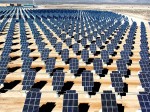Solar Energy Spike Amid Market Challenge

Solar Energy Spike Amid Market Challenge
by Milos Bezanov
Cut to renewable energy subsidies and low profit margins inhibit prices as solar market booms.
India’s Azure Power wants to increase capacity almost 100% before the end of 2016, according to a fortune article. The company intends to raise capacity to 520 megawatts and 1 gigawatt in 2016 and 2017 respectively, with current capacity hovering at the 242 megawatt mark.
The article also notes the solar energy explosion taking place in California and the U.S. According to the SEIA, the U.S. Solar market expected to grow 119% in the coming year ,” This is a new energy paradigm and the solar industry officially has a seat at the table with the largest energy producers…because of strong demand for solar energy nationwide…hundreds of thousands of well paying solar jobs will be added in the next few years benefiting both America’s economy and the environment” says SEIA president and CEO Rhone Resch.
GTM research forecasts 16 gigawatts of capacity to be installed in 2016, up from 7.3 Gw in the previous years, while Azure power raises another $60 from International Finance Corp, to add to its new IPO.
Energy saving, saving energy?
However, India’s solar market is beset with regulatory hurdles and and low profit margins, while the UK is still overcoming cut to the energy Feed in Tariffs (FiT). “It’s quite clear that good businesses are going under because they have been ambushed by sudden and deep tariff cuts” explains Jeremy Leggettounder of Solarcentury U.K. According to an SEIA article, solar “is still expected to drop on an annual basis due to the pull-in of utility PV demand in 2016”.
Markets, however are steady, “As the double digit gigagwatt utility PV pipeline is built out in 2016, utility solar is expected to experience a reset in 2017” explains Cory Honeyman, GTM Senior Research Analyst. “Between 2018 and 2020, the extension of the ITC will reboot market growth for utility PV and support continued growth in distributed solar as a growing number of states reach grid parity.”
Markets, for the moment, remain steady.
